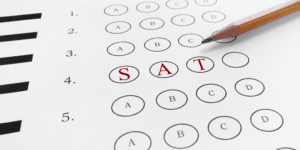Are you considering applying to graduate school? You may be wondering which graduate admissions exam you should take — the GRE or the GMAT. Until recently, the choice was clear: take the GMAT for a graduate business program (like an MBA) and take the GRE for almost any other graduate program in the arts and sciences. In 2006, however, Stanford began accepting the GRE for Business School applications, and since then more and more business schools have joined in. So if you are planning to apply to a graduate business program, which test is right for you?
The GRE Basics
The GRE is administered by the Educational Testing Service (ETS) and is accepted by thousands of graduate schools, including many business and law schools.
The GRE is designed to evaluate your verbal and quantitative reasoning, critical thinking, and analytical writing skills. It takes 3 hours and 45 minutes to complete, and it can be taken online or at a testing center. The cost is $205. Scores are good for five years, and you can retake the GRE up to five times in any 12-month rolling period. It includes the following three scored portions, as well as a possible unscored or experimental section:
- The Analytical Writing section comprises two separately timed, 30-minute writing tasks. The first requires you to construct an argument on an issue; the second involves the evaluation of a written argument. This section is scored from zero to six in half-point increments.
- The Verbal Reasoning test consists of two 30-minute sections with 20 questions each. These sections contain three question types: reading comprehension, text completion, and sentence equivalence. Verbal Reasoning is scored on a scale of 130 to 170 in one-point increments.
- The Quantitative Reasoning section is designed to test your basic math skills. It features two 35-minute sections with 20 questions each. Questions might be multiple-choice with one or several answers, numeric entry questions, or quantitative comparison questions. Topics include arithmetic, algebra, geometry, and data analysis. Again, this section is scored from 130 to 170 in one-point increments.
The GMAT Basics
The GMAT is offered by the Graduate Management Admission Council (GMAC) as an entrance exam for admission to business schools and MBA programs. It measures reasoning and critical thinking skills that demonstrate an ability to succeed in top graduate business programs. The GMAT lasts 3 hours and 30 minutes in person and 3 hours online; It costs $275 for the in-person test or $250 for the online test. As with the GRE, scores are valid for five years. You can retake the GMAT at a testing center up to five times in a rolling 12-month period and up to eight times total. With the GMAT online exam, you can retest only once.
The format of the GMAT varies depending on whether you are taking the test at a testing center or online. The in-person version comprises four sections, and you can choose to order them to fit your strengths and testing style. The online version contains three sections in a fixed order:
- The Analytical Writing section, offered only in the test center, asks you to analyze and critique a written argument in one 30-minute writing task. It is scored from zero to six points in half-point increments.
- The Integrated Reasoning section is designed to measure your ability to use data to solve complex problems. This portion consists of one 30-minute section with 12 questions (mostly multiple choice). You’ll be asked to examine and analyze data from multiple sources, including tables and graphs, as well as solve both quantitative and verbal problems. The score ranges from one to eight in one-point increments.
- The Verbal Reasoning section lasts 65 minutes and contains 36 questions designed to test your ability to read, understand, and evaluate written materials. Questions in this portion include reading comprehension, critical reasoning, and sentence correction. This section is scored from six to 51 points in one-point increments.
- The Quantitative Reasoning section has 31 multiple-choice questions which you have 62-minutes to complete. Questions include Data Sufficiency problems, which ask you to determine whether you have enough data to answer a given question. As on the Verbal section, you can earn from six to 51 points in one-point increments.
You can find more information about the structure of each test from the respective web sites: ets.org/gre and mba.com/gmat.
Key Differences Between the GRE and the GMAT
The GMAT is used only for Business School admissions, while the GRE is accepted by most Graduate Schools and many Business and Law Schools. The GRE, therefore, provides flexibility to apply to many different kinds of programs. If you are unsure of your graduate school path, the GRE will preserve your options and allow you to change your mind. Let’s assume, though, that you are dead-set on Business School. Which test should you take? How do you decide?
First, do Business Schools give equal consideration to the two tests? To put it bluntly, do they really prefer the GMAT? Most Business Schools that accept both tests claim that they give equal consideration to either, but some openly admit a preference for the GMAT. Cindy McCaulley, Director of Admissions at Carnegie Mellon’s Tepper School of Business, explains: “We prefer the GMAT because it was created specifically to evaluate business-school candidates. However, we will accept the GRE, and those applicants are evaluated in the same way.” In contrast, Isser Gallogly, Associate Dean of MBA Admissions at NYU Stern, expresses no preference: “We evaluate applicants across three dimensions: their academic profile, professional achievements, and personal characteristics. Within the academic profile, the GMAT or GRE is assessed along with GPA.” So, if you have a specific school in mind, you should definitely explore whether it has a preference.
Assuming that your target school accepts both tests equally, the real question you need to answer is: Which test can I do better on? Several factors will come into play.
Math Component of the GRE versus the GMAT
Most test-takers find the Quantitative/Math component of the GMAT more challenging than its counterpart on the GRE. The two tests cover a similar pool of mathematical topics: arithmetic and number properties, algebra and functions, exponents and roots, plane and coordinate geometry, statistics, basic probability, and combinatorics (permutations and combinations). The GMAT, however, poses more difficult problems and generally demands a greater depth of mathematical knowledge. The wording of GMAT questions is trickier, and GMAT math problems are more difficult to read and interpret than those on the GRE.
Both the GRE and the GMAT, moreover, contain their own peculiar question type, which you are unlikely to have encountered elsewhere. On the GRE, this is the Quantitative Comparison question, which offers you two mathematical expressions accompanied by related information. Your task is to choose among four options: Quantity A is greater, Quantity B is greater, Quantities A and B are equal, or you don’t have enough information to make the determination.
On the GMAT, Data Sufficiency questions present you with a question, followed by two statements, 1 and 2. You must select from five options: Statement 1 alone is sufficient to answer the question but statement 2 is not; Statement 2 alone is sufficient to answer the question but statement 1 is not; Statements 1 and 2 together are sufficient, but neither is sufficient by itself; Both statements are individually sufficient; Both statements together are insufficient.
Many students find Data Sufficiency problems especially difficult. Both Quantitative Comparisons and Data Sufficiency questions take some getting used to, even for test-takers with strong math skills.
Another factor to consider in the Math area is that the GRE provides you with an on-screen calculator to use in the Quant sections. The GMAT does not allow calculator use on the Quant section. This is a critical factor for some students.
Verbal Sections of the GRE & GMAT
The big difference between the GMAT and the GRE on the Verbal side is that the GMAT tests your knowledge of standard English grammar and usage via Sentence Correction questions, while the GRE places a premium on vocabulary with Text Completion and Sentence Equivalence questions. If your vocabulary and verbal skills are particularly strong, the GRE might be the better test for you. If your vocabulary is relatively weak, you may find the GRE challenging. The GRE does not explicitly test grammar and usage.
GRE & GMAT Test Structure
The GRE and the GMAT are structured differently, in ways that may influence your decision. The GMAT is a fully Computer-Adaptive Test. This means that when you get a question right, the next question will be more difficult, and when you get a question wrong, the next one will be easier. The GMAT algorithm is constantly adapting the test to you. This has major implications for scoring and for test-taking strategy. For scoring, it means that different questions will “count” differently. If you get several consecutive questions wrong in the early part of the section, it may be almost impossible to raise your score above a certain range. The adaptive nature of the test means that you are unable to mark a question for review to return to later, or to go back to an earlier question at all.
The GRE is adaptive by section, but not within the section. Thus, your performance on the first Verbal or Quant section will influence the content of the second section in the same area, but your response to each question does not affect which question comes next within a section. The GRE, therefore, lets you move around within a section and even provides a tool to let you mark questions to return to. You can go back, review a question, and change your answers until time expires.
Deciding Between the GRE and the GMAT
Given these differences in content and structure, how can you decide which test is right for you? Take and score a practice GMAT and a practice GRE! Both ETS and GMAC offer a variety of prep materials, including two full, free practice tests. You can download them from the respective websites and take them under simulated test conditions. The software will score them for you and allow you to compare your results; you will also be able to experience the differences between the two tests and begin to develop a sense of which one you would be more comfortable taking.
Whichever test you opt to take, preparation is crucial. You will need to refresh your knowledge of high school geometry and algebra before taking on either the GRE or the GMAT. To deal successfully with Quantitative Comparison or Data Sufficiency questions, you need to become familiar with them and spend time practicing. The GRE has some questions that require you to select one answer choice, some that require you to make two choices, and some that ask for an undetermined number of answer selections. You do not want to be reading the instructions and figuring this all out on test day! On the GMAT, the scoring algorithm makes it critical for you to develop a disciplined approach: you should identify questions that are taking you too much time and be willing to guess and move on. Whether you opt to work with a tutor, take a structured class, or prepare on your own, systematic preparation and practice are key to success on either test.
The good news is that you have a choice! Consider all the factors reviewed here, and choose the option that works for you. And whatever you decide: our online GRE tutors & GMAT tutors are here to help.




